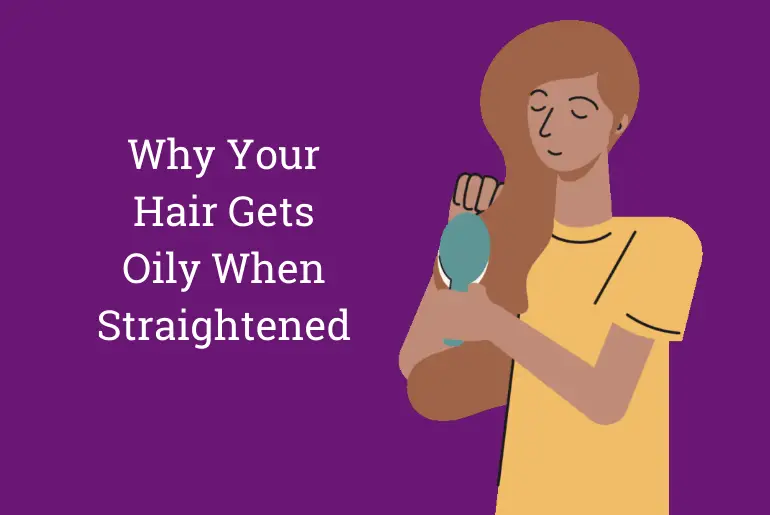One of the biggest issues with hair when it comes to styling is the oil level. Oily hair makes it difficult to style and often leads to a greasy feeling at the end of the day or by late afternoon.
It can look best when straightened or blown straight but looks horrible after a few hours because it seems like the hair gets oily from within, almost like your scalp produces too much oil for your strands to handle.
It is frustrating when you have just spent time and money straightening your hair, and you look in the mirror the next morning to see that it is all flat again. Oily hair can make styling a nightmare and cause days of washing and blow-drying to have been in vain.
This article will explain why you experience oily hair when you straighten it and how to manage it. We also tell you the steps to stop your hair from getting oily while straightening.
11 Reasons/Mistakes that Are Making Your Hair Look Greasy

There are a few reasons that your hair can get oily when you straighten it. Here are some of the few reasons for that:
1. You’re shampooing too often
If you have dry hair, you might have the habit of washing your hair every day. However, this can strip it of all its natural oils, making it even drier and more prone to getting frizzy. So try leaving your hair unwashed for a few days (or at least until it gets oily), and then use a clarifying shampoo and conditioner to help eliminate any product build-up.
2. You’re applying conditioner incorrectly
Washing your hair with shampoo and then applying conditioner is not the best way to go about it. Conditioners are for the ends of your hair, not the roots, “If you’re using it near your scalp, you’re definitely going to get greasy.”
Try using a clarifying shampoo once a week to strip away all the oils that have accumulated at the root. Then apply a moisturizing conditioner just below where you would normally towel dry (about an inch from your scalp). Leave it on for a minute or two before rinsing thoroughly.
3. Your showers are too hot
Hot water can strip your hair of its natural oils, which means your follicles will produce more oil to compensate. To combat this problem, shower at lower temperatures and use a gentle shampoo and conditioner (or try the clarifying method). If you have very oily hair, consider using a sulfate-free shampoo so that it doesn’t strip your scalp of oil.
4. Your styling products are too heavy
If your hair is getting greasy and you’re not sure why it could be your styling products.
If you’re using too much product or the wrong product for your hair type, it can cause buildup, making your hair look dull and greasy.
Your hair looks best when it’s shiny, bouncy, and full of volume. But if it gets oily quickly, that doesn’t mean you need to change up your shampoo or conditioner. Just switch up your styling products!
Try using a lighter-weight gel or mousse on wet hair instead of heavy cream or gel. And use a volumizing shampoo and conditioner that will give you the lift and bounce you want without weighing down your strands.
5. You’re straightening your hair too often
If you’re only doing this once or twice a week, that’s fine, but if you’re straightening every day, your scalp is working overtime trying to produce enough oil as quickly as possible. Over-processing of this nature can cause temporary damage to the structure of the strands, which means they can’t hold onto moisture as effectively and will begin to feel limp and lifeless.
6. Hair styling tools are dirty
If you use dirty items to style your hair, such as brushes and curling irons, it can cause problems on the scalp. If you use a dirty comb or brush on your hair, you can transfer oil and dirt from the tool to your locks.
7. Overuse of Heat-Styling Tools
If you are using heat-styling tools on your hair every day, it is likely that you are causing damage to it. Overusing these styling tools will lead to increased oil production and greasiness on the scalp.
Excessive heat exposure to hair can cause hair oil glands to overproduce sebum, leading to oily hair. When heat is applied to the hair, it can cause the hair follicles to enlarge, allowing more oil to escape from the scalp and onto the hair. This can result in an increase in oiliness, especially when heat-styling tools are used frequently.
8. Using the Wrong Products
Certain hair products can contain ingredients that can clog hair follicles and the scalp, leading to an increase in oil production. This can be especially problematic for people with naturally oily hair or scalps. Be sure to choose hair products that are suitable for your hair type and free of heavy oils and silicones.
9. Over-Brushing
Brushing hair too frequently can stimulate the scalp and oil glands, causing an increase in oil production. This is because brushing can distribute oils from the scalp to the rest of the hair, making hair appear greasy and oily. To minimize this effect, limit your brushing to twice a day, and use a wide-tooth comb instead of a brush to detangle hair.
10. Genetics
Oily hair can be hereditary, meaning it is passed down from parent to child through genes. If you have a family history of oily hair, you may be more prone to this problem. In this case, it is best to focus on preventative measures, such as using the right hair products and avoiding over-brushing.
11. Medical Conditions
Medical conditions such as seborrheic dermatitis, polycystic ovary syndrome (PCOS), and thyroid imbalances can cause oily hair. In these cases, it is important to consult a doctor or dermatologist to determine the underlying cause and develop an appropriate treatment plan.
10 Ways to Make Your Hair Less Greasy
If you’ve just straightened your hair, chances are you’ll want to keep it that way. But straight hair tends to get greasy quickly, especially in humid weather. Here’s how to make your hair look good longer:
1. Use dry shampoo
If you have oily hair and straighten it, your hair will get greasy quickly. The best way to prevent this is to use dry shampoo.
Dry shampoos soak up excess oil and make your hair look clean again. It also adds texture and volume to flat, straight hair.
A dry shampoo is an excellent tool for fighting greasiness. It helps remove excess oil and product build-up without stripping your hair of its natural oils. You can use it between washes to keep your hair looking fresh and clean.
2. Balance your brushing
Over-brushing can make your skin produce excess oil. On the other hand, not brushing your hair enough does not allow it to distribute natural oils properly. Pay attention to what works best for your hair, and keep doing it.
3. Wash your hair less
You can use good shampoo and conditioner, but you should also try to wash your hair less often. Washing your hair too often can make it greasy.
If you have straightened hair, you need to be careful about how often you wash it. The more frequently you wash your hair, the more oil will come out of your scalp. So, if you want to make your hair less greasy after straightening, then wash your hair less often than usual.
Although it might seem unreasonable, if you constantly remove your hair’s oils through washing, it will replace them at an accelerated rate.
4. Try not to touch your hair
This can be difficult; always try to minimize the amount of oil your fingers pick up by washing them frequently with soap and water. Also, don’t touch or massage your hair too much, especially near the root, where it is most vulnerable to damage.
5. Choose your products wisely
Limit yourself to a few gel varieties, but not because experimenting is wrong. Rather, you can look like an oil slick if you use too many products on your hair at once.
6. Avoid straightening your hair always
If you have oily hair, try to avoid straightening as much as possible. If you must, try using heat protectors and good quality products to help reduce damage.
If you constantly straighten your hair with heat tools such as flat irons or blow dryers, this will contribute to more grease in your hair because it’s fried from all the heat applied. The best thing for most people is to avoid using these tools altogether or at least limit their use as much as possible.
7. Reduce Heat Styling
Limiting the use of heat-styling tools, such as straighteners, curling irons, and blow dryers, can help reduce oiliness. Try to let your hair air dry whenever possible, and avoid using heat-styling tools more than two to three times a week. If you must use heat-styling tools, be sure to use a heat protectant spray to help minimize damage and oiliness.
8. Use the Right Products
Choosing the right hair products can make a big difference when it comes to oiliness. Look for products that are specifically formulated for oily hair, such as shampoos and conditioners that are free of heavy oils and silicones. Additionally, avoid using hair products that contain ingredients that can clog hair follicles and scalp, such as petroleum, mineral oil, and sulfates.
9. Avoid Over-Brushing
As mentioned earlier, over-brushing can stimulate the scalp and oil glands, leading to an increase in oil production. To minimize this effect, limit your brushing to twice a day, and use a wide-tooth comb instead of a brush to detangle hair.
10. Keep Scalp Clean and Healthy
A healthy scalp is essential for healthy hair. Be sure to keep your scalp clean and free of buildup by washing hair regularly and using a gentle exfoliating scrub or brush. Additionally, avoid using harsh hair care products that can damage the scalp and increase oil production.
Which Oil Is Best for Hair?
If you’re wondering which oil is best for hair, the answer is all of them. Or at least most of them. The trick is to use the right kind of oil for your hair type, whether it’s dry, oily, or somewhere in between, and also to use it properly.
Oils like Coconut oil, Almond Oil, Olive Oil, and many more are good for your hair.
Should I Straighten My Hair Every Day?
Straightening your hair every day is a No-No.
Straightening your hair heats it up and damages your hair follicles, which can cause split ends and breakage over time. This is why most experts recommend that you only straighten your hair once a week or less.
If you choose to use heat on your hair more than once a week, you should use a heat protectant before applying heat to your hair. A heat protectant will help to prevent damage from occurring as quickly as it would otherwise. It also helps keep your hair hydrated so it remains healthy and strong during styling.
Conclusion
One of the reasons for this is a chemical reaction between your hair, your scalp, and your hair products. Smooth surfaces and shiny products generally indicate a smoothing product that may cause build-up in your hair follicles.
This buildup is what can make your hair look oily, so it’s best to avoid products with shine or silicones that block pores.
Many types of hair care products on the market are specifically designed to combat this problem. You should consider one of the options mentioned in this article.






